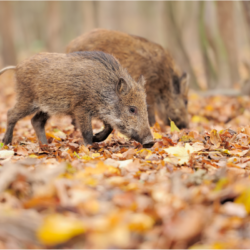Hantavirus is a potentially serious viral disease, transmitted mainly by rodents. Its symptoms are similar to those of influenza in the early stages, but it can develop into severe complications such as hantavirus pulmonary syndrome (HPS) or haemorrhagic fever with renal syndrome (HFRS).
This animal disease is not considered contagious. Legislation does not include it among the notifiable human diseases. The agricultural and general schemes list it as an occupational disease under Tables 56 and 96 respectively. The worker or his heirs must make the declaration. The French Labour Code classifies the Puumala virus in hazard group 2 (R. 231-61-1).
Which virus is responsible?
The term haemorrhagic fever with renal syndrome (H FRS) covers similar diseases caused by Orthohantaviruses of the Hantaviridae family. Also known as Korean haemorrhagic fever, epidemic haemorrhagic fever or epidemic nephropathy, it is caused by viruses such as Hantaan, Dobrava-Belgrade, Saaremaa, Seoul and Puumala, found in Europe, Asia and Africa. The Hantaan and Dobrava viruses cause the most severe forms of HSRF.
HFRS and hantavirus pulmonary syndrome (HPS) are linked to immunopathological phenomena, in which inflammatory mediators play a key role. HPS, caused by viruses such as Black Creek Canal (BCCV), New York (NYV ) and Sin Nombre (SNV), is endemic in the United States and Canada. The main hosts of these viruses are the hispid cotton rat in Florida, the deer mouse in Canada and the western United States, and the white-footed mouse in the eastern United States.
Orthohantaviruses are enveloped viruses with single-stranded RNA of negative polarity, 180 to 115 nm in diameter. They infect a variety of rodents, depending on the region: Apodemus spp. (Hantaan and Dobrava-Belgrade viruses in Asia and the Balkans), Clethrionomys (Puumala virus in Europe and China), Peromyscus and Microtus (Sin Nombre virus in the United States), and Rattus spp. (Seoul virus worldwide).
Hantaviruses cause two main syndromes in humans: FHSR and SPH. In France, the Puumala virus causes a mild form of HSRF known as epidemic nephropathy. American hantaviruses cause HPS, with around 200 cases a year and a mortality rate of 40%. HFRS, with 150,000 to 200,000 cases a year, has a mortality rate of 1% to 12%, mainly in China.
How does the disease manifest itself in animals?
The Puumala virus mainly infects bank voles. In France, it is found in the north-east and central Europe, from Scandinavia to Russia and Germany. Other hantaviruses are found in the United States and Eurasia.
The Puumala virus is transmitted by contact with the saliva and faeces of infected rodents. Symptoms in reservoir animals are generally not apparent.
The hosts of the virus vary from region to region:
- Apodemus spp. host the Hantaan and Dobrava-Belgrade viruses in Korea, China and the Balkans.
- Clethrionomys harbour the Puumala virus in Scandinavia, the Commonwealth of Independent States and China.
- Peromyscus and Microtus harbour the Sin Nombre virus in the United States.
- Rattus spp. carry the Seoul virus worldwide.
In Belgium, the bank vole is the main host of hantaviruses. It lives in deciduous forests, scrub, woodland edges and parks, and sometimes enters houses in winter. This small rodent measures 8 to 12 cm, with a reddish-brown back and greyish sides.
The genus Apodemus includes small rodents of the family Muridae, often called field mice. They are lively and fast, good runners and jumpers, with a long tail and large ears. In Europe, known species include the Striped Mouse(Apodemus agrarius), the Collared Mouse(Apodemus flavicollis) and the Woodland Mouse(Apodemus sylvaticus). These rodents can carry the hantavirus.
Voles, which belong to the subfamily Arvicolinae, are often confused with field mice or shrews. They are brown, stockier with a shorter tail and often live underground. The genus Peromyscus, or white-footed mouse, belongs to the family Cricétidés.
How are they infected?
The hantavirus is transmitted mainly by inhalation of dust contaminated by the droppings of infected rodents. In France, between 50 and 100 cases are recorded every year, around 50% of them in the Ardennes, with a higher frequency in years when the bank vole population is increasing.
Occupations at risk include work in forestry, earthworks, renovation or cleaning of uninhabited premises (barns, sheds). Risk factors include handling wood and dry sweeping of premises that have been unoccupied for long periods, especially if they are in or near forests. Aerosol transmission of rodent excrement is the main mode of contamination.Inhalation of viral particles from the urine, faeces or saliva of infected rodents is the most common means of transmission to humans.
Infected rodents remain carriers of the virus throughout their lives, excreting it in their urine and faeces without developing the disease. Cases of hantavirus increase when the local rodent population is abundant and/or heavily infected.
There is no known human-to-human transmission. Humans contract the infection by inhaling airborne droplets of saliva or urine, or dust from excrement. Transmission can also occur through direct contact between contaminated material and broken skin, or through ingestion of contaminated food or water, although this is less common.
In Europe, there is no risk of human-to-human transmission.
What does hantavirus look like in humans?
The clinical features of patients with hantavirus disease range from asymptomatic to severe. The incubation period is generally 2 to 3 weeks, but can extend to six weeks. In endemic areas, hantavirus infection is suspected if acute fever is accompanied by thrombocytopenia, severe headache, and abdominal and back pain without clear respiratory symptoms. After a week, the clinical course may differ depending on the type of hantavirus: haemorrhagic fever with acute renal failure (HFRS), nephritis (NE ) or hantavirus cardiopulmonary syndrome (HPS).
Hantaviruses mainly affect the lungs (SCPH) and kidneys (FHSR). Puumala virus has a mortality rate of 0.1-0.4%. Kidney syndrome is common in Europe, Korea, China and Russia, with the Seoul virus spreading globally via rats on boats. Cases of hantavirus infection transmitted by domestic or laboratory rats have been reported in the United States, Canada and Europe.
Haemorrhagic fever with renal syndrome
Haemorrhagic fever with renal syndrome (H FRS) can range from mild to severe depending on the causative agent. Symptoms of HSRF generally appear 1 to 2 weeks after exposure to the virus, but can take up to 8 weeks to appear. They begin suddenly. If they progress, more serious symptoms can occur, such as a drop in blood pressure, acute shock, vascular extravasation and acute renal failure.
The clinical course is divided into five phases:
- Prodromal phase: Sudden onset with high fever, chills, headache, blurred vision, malaise, anorexia, abdominal and back pain, gastrointestinal symptoms, facial flushing, petechiae and erythematous skin rash. Lasts 3 to 7 days.
- Hypotensive phase: This is characterised by sudden hypotension, which can progress to shock and haemorrhage. Lasts from a few hours to several days.
- Oliguric phase: Blood pressure may return to normal or increase. Urinary output falls and severe haemorrhage may occur. Lasts 3 to 7 days.
- Diuretic phase: Diuresis increases to 3 to 6 litres per day, marking the start of recovery. May last several days to a few weeks.
- Convalescence phase: Symptoms gradually diminish. Full recovery may take weeks to months.
Infections with the Hantaan and Dobrava viruses are generally more severe, while the Seoul, Saaremaa and Puumala viruses cause milder symptoms. The mortality rate for HFRS varies from 5% to 15%. Renal failure may be a permanent consequence in some patients. Recovery can take up to 6 months.
Hantavirus pulmonary syndrome
Hantavirus pulmonary syndrome has four clinical phases: prodromal, cardiopulmonary, diuretic and convalescent.
- Prodromal phase: Characterised by fever, myalgia, malaise, headache, dizziness, abdominal pain and gastrointestinal symptoms, generally lasting 3 to 6 days.
- Cardiopulmonary phase: Rapid onset with non-cardiogenic pulmonary oedema, hypoxaemia, cough, pleural effusion, tachypnoea, tachycardia, myocardial depression and cardiogenic shock. There is also a risk of hypotension and oliguria. This phase often leads to acute respiratory failure, despite respiratory assistance and powerful diuretics. Mortality is around 30%.
- Diuretic phase: Marked by rapid resorption of pulmonary oedema, resolution of fever and shock.
- Convalescence phase: Rapid improvement in health, with full recovery in 2 to 3 weeks for those who survive the first few days.
Prodromal symptoms include flu-like symptoms such as fever, cough, myalgias, headache, lethargy and dyspnoea. Dyspnoea rapidly progresses to acute pulmonary oedema, which is often fatal. The fatality rate varies from 30% to 60%.
Patients develop a cough and shortness of breath that can worsen within a few hours, with accumulation of fluid around the lungs and a drop in blood pressure. Mortality is around 50%. Survivors improve rapidly.
The main hantaviruses responsible are Sin Nombre, Andes and Choclo. Others include Black Creek Canal, Muleshoe, Bayou, New York virus, Convict Creek and Isla Vista in North America, and Laguna Negra, Andes-like, Lechiguanas, Oran, Central Plata and others in South America.
The syndrome begins with a sudden onset of fever, myalgias, headaches and gastrointestinal symptoms, followed 2 to 15 days later by acute non-cardiogenic pulmonary oedema and hypotension. Moderate cases of hantavirus pulmonary syndrome are possible, sometimes associated with haemorrhagic fever and renal syndrome.
How is this condition diagnosed?
Diagnosis of hantavirus disease is based primarily on the detection of antibodies using immunofluorescent assays (IFA) or enzyme immunoassays (EIA). In the acute phase, the low avidity of IgG antibodies and granular fluorescence can distinguish recent from old infections. IgM immunochromatographic tests with optical readers have recently been developed. RT-PCR of the patient’s blood is also used. Diagnosis is based on serological tests, detection of antigens or detection of the genome by PCR. It must be confirmed by the presence of specific antibodies against the virus in the patient’s blood. Clinical symptoms and laboratory tests, such as hypoplaketosis, are essential. Kidney damage is often detected by laboratory tests showing proteinuria and elevated creatinine.
FHRS
FHSR is difficult to diagnose on clinical grounds alone, and serological results are often essential. A four-fold increase in IgG antibody titre in one week and the presence of IgM antibodies against Orthohantaviruses confirm acute infection. HSRF should be suspected in patients with acute flu-like fever, renal failure of unknown origin, and sometimes liver damage.
Diagnosis is based on serological tests or polymerase chain reaction (PCR). Suspicion of HFRS is aroused in exposed individuals presenting with fever, a tendency to haemorrhage and renal failure. Doctors perform CBC, ionogram, renal function tests, coagulation tests and urine analyses.
The presence of thrombocytopenia, proteinuria and microhaematuria quickly confirms the presumptive diagnosis of a hantavirus infection. During the hypotensive phase, the haematocrit increases, with hyperleukocytosis and thrombocytopenia .Albuminuria, haematuria and red and white blood cell cylinders are observed between days 2 and 5. During the polyuric phase, fluid and electrolyte disorders are common.
The diagnosis of HSRF is ultimately confirmed by serology or PCR.
HPS
Hantavirus infection is suspected in exposed individuals with characteristic symptoms. Blood tests confirm the diagnosis by identifying the virus. The doctor carries out further blood tests to assess the function of the kidneys and other organs. If cardiopulmonary syndrome is suspected, a chest X-ray and echocardiography are performed to rule out other causes of fluid around the lungs. Tests include serological analysis and PCR (polymerase chain reaction).
Hantavirus pulmonary syndrome is suspected in cases of possible exposure and unexplained pulmonary oedema, diagnosed clinically or by X-ray. The chest X-ray may show increased vascular meshwork, Kerley’s B lines, bilateral infiltrates or pleural effusions. An echocardiogram is performed to rule out pulmonary oedema of cardiac origin.
Additional tests include a CBC, liver function tests and urinalysis. Hantavirus pulmonary syndrome causes mild neutrophil hyperleukocytosis, haemoconcentration and thrombocytopenia. A modest elevation in lactic dehydrogenase,aspartate aminotransferase and alanine aminotransferase, with a decrease in serum albumin, is typical. Urine analysis shows minimal abnormalities.
Diagnosis of hantavirus pulmonary syndrome is based on serological tests or reverse transcriptase-PCR.
What is the treatment?
Treatment of hantavirus disease is mainly symptomatic. Maintaining fluid balance is crucial, while avoiding overhydration in oliguric patients. In cases of renal failure, dialysis may be necessary. Given the absence of human-to-human transmission of European hantaviruses, no isolation is required. There is no cure or vaccine for HSRF or HPS.
For HSRF, treatment is symptomatic, with resuscitation and possibly renal dialysis. Ribavirin, administered in China and Korea within 7 days of the onset of fever, has been shown to reduce mortality and the duration of the disease.
For hantavirus cardiopulmonary syndrome, patients receive oxygen and medication to stabilise blood pressure. Mechanical ventilation may be necessary during the critical respiratory phase. In severe cases, extracorporeal membrane oxygenation (ECMO) may be necessary.
In cases of renal syndrome, dialysis and intravenous ribavirin may reduce the severity of symptoms and the risk of mortality.
Similarly, the treatment of hantavirus pulmonary syndrome is symptomatic. It may require mechanical ventilation, meticulous control of blood volume and vasopressors. In cases of severe cardiopulmonary failure, ECMO can be life-saving.
Ribavirin has not been shown to be effective in hantavirus pulmonary syndrome. Fever and headaches are treated with analgesics containing paracetamol, avoiding non-steroidal anti-inflammatory drugs and aspirin to avoid aggravating haemorrhage. The prognosis is generally good, with recovery in 2 to 3 weeks, although fatigue may persist. If left untreated, the infection can lead to coma and death.
What preventive measures are available?
Preventive measures against hantavirus infections in infested areas include:
- General hygiene of premises:
- Combat the presence of rodents: avoid attracting them (food deposits, cluttered premises, storage of wood in inhabited rooms) and prevent their access (plug openings).
- Limit exposure to dust when cleaning unoccupied premises.
- Employee training and information:
- Provide information on the risks associated with hantavirus, hygiene and preventive measures.
- Provide appropriate resources: drinking water, soap, disposable wiping materials, first aid kit.
- Use appropriate, well-maintained work clothing and personal protective equipment.
- Reduce sources of contamination:
- Wear resistant, waterproof gloves when handling rodent corpses.
- Observe hygiene rules. Wash and disinfect any wounds.
In a high-risk area, we recommend :
- Wear gloves and a respirator mask (FFP2 minimum) when handling piles of wood and cleaning unoccupied premises.
- Ventilate sheds and storage rooms before use, avoid direct contact with rodent droppings, and wear a mask to avoid inhaling contaminated aerosols.
Measures specific to the home include:
- Place animal provisions and food out of reach of rodents.
- Prevent rodents from entering homes by blocking openings.
- Eliminating potential rodent shelters.
- Place traps or use rodenticides.
- When closing a room for the winter, check that there are no rodents in it. When opening after winter, ventilate the premises for at least 30 minutes before cleaning the floors with a 10% bleach solution.
Some epidemiological data…
More than 10,000 cases of HFRS are diagnosed each year in Europe, and this number is rising. In 2017, 21 countries reported 4,239 cases of hantavirus infection, or 0.8 cases per 100,000 inhabitants. Finland and Germany accounted for 70.1% of reported cases. In the absence of a vaccine, prevention is based on controlling rodents, avoiding contact and properly cleaning contaminated areas.
The two most common hantaviruses in Europe are Puumala and Dobrava.
- Puumala: Widespread across most of Europe (except the UK, the Mediterranean and the north).
- Dobrava: Present in south-eastern Europe as far south as the Czech Republic and southern Germany.
- Saarema: Widespread in Central and Eastern Europe and the Baltic States.
- Tula: Found in voles in several European countries. Low pathogenic potential for humans.
Other hantaviruses include :
- Seoul: Ubiquitous, but rare human cases in Europe.
- Tatenale, Nova, Bruges, Landiras, Seewis, Asikkala, Boginia, Brno: Detected in various small mammals in Europe, human pathogenicity unknown.
In France, the Puumala virus is the most widespread, causing localised epidemics. The Seoul virus has caused a few human cases, mainly in Paris. The Tula virus was detected in a patient in 2015. In French Guiana, the Maripa virus has caused 11 human cases, 5 of them fatal. This virus is a variant of Laguna Negra, found in South America.
Hantaviruses are also present in the islands of the south-east Indian Ocean, such as the Mayotte virus, a variant of the Thailand virus, associated with the black rat. The zoonotic nature of this virus has not yet been demonstrated. In the United States, sporadic cases of hantavirus infection, such as the Andes virus in South America, also show that human-to-human transmission is rare but possible.





